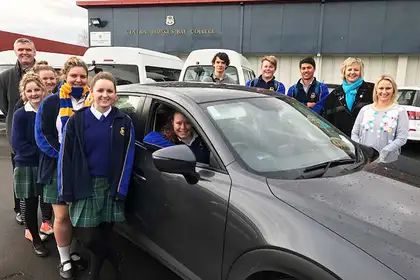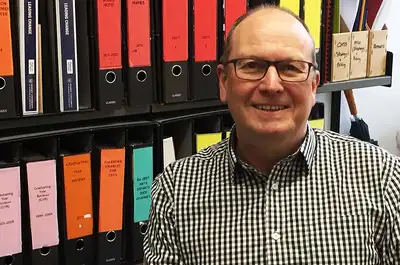
Driving students from Central Hawke's Bay College with Mayor Alex Walker and pilot convener Kelly Annand.
Compulsory driver’s licence education at secondary schools is being endorsed by new research from Massey University on the grounds it will make a big difference in helping young people get jobs.
Dr Peter Rawlins, author of the Steering Aotearoa Driving Training Pilot report, says his evaluation of a programme in Central Hawke’s Bay highlights multiple benefits for secondary school pupils and their families if formal driver education to encourage teenagers to get their full licence at school is made available.
Other key benefits from offering driving lessons at school include a boost to teens’ sense of independence and development as responsible adults, as well as reducing family tensions that can arise when parents are the main driving instructors.
Providing a structured, NCEA-accredited programme with professional driving instructors would also equip young people with safe driving skills and behaviour at a critical age, Dr Rawlins says, with the notable benefit of helping reduce road crashes, injuries and death.
Cost is often cited as a major barrier for many young people in getting a full driver’s licence, says Dr Rawlins, from the Institute of Education. This can result in illegal driving and subsequent infringements that add further costs and complications, including limiting opportunities in finding work.
School-based drive education would go a long to preventing this, he says. It costs $93.90 for a learner’s licence, $134.80 for a restricted and $109.50 for a full licence.
He presented his findings to the Mayoral Task Force for Jobs AGM at the Local Government New Zealand conference in Auckland, which the task force is part of. They endorsed a remit based on the research findings to lobby the government to support the implementation of a free and all-inclusive universal driver’s licence programme at NCEA level two.
Many rural mayors are especially keen to see the programme made widely available because of the challenges young people face in getting to jobs in rural areas during and beyond their school years.
Teens behind the wheel
The Steering Aotearoa pilot scheme came about when Central Hawkes Bay’s Economic Development Strategy group looked at some of the issues associated with employment, training and education. The conclusion? – too many young people were leaving high school without a driver’s licence, which resulted in a major barrier to local employment.
A small working group led by Kelly Annand, director of Connecting for Youth Employment, developed a driver training programme for Central Hawke’s Bay College in Waipukurau, with the primary aim to give all pupils the opportunity to obtain their full driver’s licence before they left high school.
Twenty pupils aged 16+ were selected to be part of the Mayor’s Taskforce for Jobs-funded pilot, partnering with Massey’s College of Humanities and Social Sciences, which funded the research and evaluation report.
At the start of the programme, pupils studied the road code and did practice online tests to sit their learner licence. Those who failed any part of their licence were given extra support to re-sit until they passed. During the six months’ they are required to have a learner licence before they can sit their restricted licence test, they spent time in the school holidays with instructors and mentors who taught them the basics of driving.
They then received six one-hour driving lessons from a professional driving instructor throughout the next six months, as well as additional 52 hours practice with mentors (family, friends of family, community volunteers – including retired police officers and business people). They also did a nine-hour professional defensive driving course. All who took part passed their learner’s, restricted and defensive driving tests and are currently working towards gaining full licences once the one-year restricted period was over. Five of the 20 pupils have left school and gone on to full time work, and all 20 will be supported till they receive their full driver’s licence, says Mrs Annand.

Steering Aotearoa report author Dr Peter Rawlins.
Driving in decline?
Dr Rawlins says research indicates that over the last 15 or 20 years, there has been a decline in the driver licence rate amongst young people, particularly in developed countries.
Reasons given include: a decline in youth employment, students staying at school longer, an increase in attendance at tertiary institutions, and an increase in the age of marriage – all suggesting an extension of youth, and the delaying of entry into full-time work. Other factors are “changes to socialisation patterns for young people, with a reduction in the status of the car, and a trend towards more online interaction.”
“Put simply, research suggests that many young people do not see obtaining a driver licence as an urgent priority.”
However, the need for a full driver’s licence is critical for many living outside main centres with little or no public transport. Shift work is off-limits with only a restricted licence, though research shows many do end up driving illegally to get to work.
Sense of achievement
A number of learner drivers said that gaining a driver’s licence gave them a strong sense of achievement. “Some reported that they have had limited success in their life and so progressing through the GDL gave them something to be proud of,” Dr Rawlins says.
Another parent explained how her son’s confidence had grown saying that: ‘It’s made him more confident because…he’s a kid that didn’t think he could do things but he sees now that he can.”
Social media enhancing driver achievement
The use of social media helped organise activities as well as celebrate success. Mrs Annand posted messages via Facebook to alert parents that their child had a driving practice session coming up. Pupils also kept in touch with each other through other social media platforms – though not while driving!
Parents too felt that the use of social media help create a community that encouraged everyone to succeed. They also felt included and supported by the programme, says Dr Rawlins, and appreciated the structured nature of the pilot.
“Some parents were anxious that they may have picked up ‘bad habits’ and appreciated having other mentors to ensure that students learned to drive correctly. Even if they were showing the student the correct way to drive parents felt that the messages were often received more effectively if they came from the professional instructor.”
One of the most anticipated aspects was that it would increase young people's independence and “reduce the need for parents to act as a ‘taxi service’,” says Dr Rawlins.
Mrs Annand says she is “extremely proud” of the young people involved and progress so far.
“We firmly believe that if we could see driver training in schools it would reduce offending rates, keep young people in school until they were ready to leave for employment, set them up to be more employable and most importantly teach them the importance of safety and good legal driving practices on our roads.”